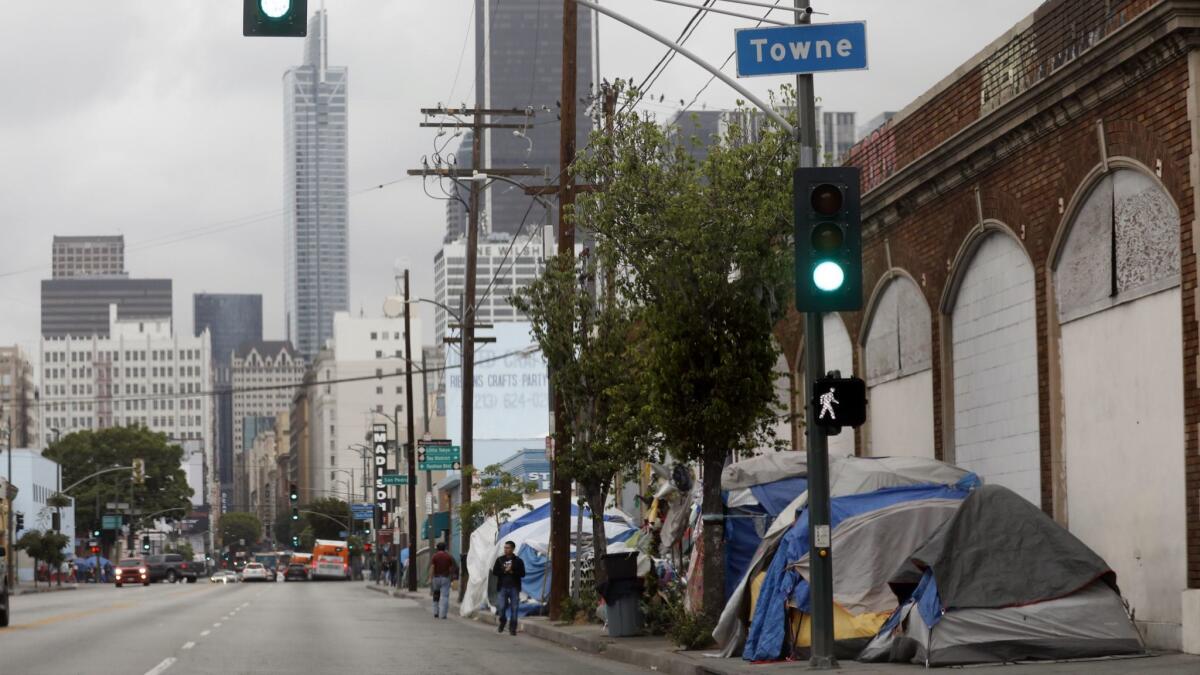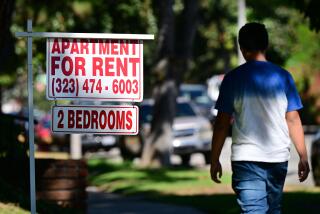High cost of housing drives up homeless rates, UCLA study indicates

Sky-high housing costs are a significant factor behind California’s homeless crisis, according to a new analysis from UCLA.
In a study contained in the latest UCLA Anderson Forecast, released Wednesday, UCLA found that higher median rent and home prices are strongly correlated with more people living on the streets or in shelters. The research backs other studies that have found a similar relationship.
Last year, Zillow released a study that showed that a 5% rent hike in L.A. County — where more than 50,000 are estimated to be homeless — would cause 2,000 additional people to lose their homes.
In April, according to Zillow, the median rent for a vacant apartment in the county was $2,462, up 1.9% from the previous year. In 2017, rents climbed an average of 4.3% and in 2016, 6.5%. The median home price in April was $608,800, up 9% from a year earlier.
“If we can improve the affordability and the availability of the general housing market … I think it will help in reducing the homeless problem,” said William Yu, the UCLA economist who conducted the research.
In the study, Yu compared homeless rates and housing costs in all 50 states, plus Washington, D.C. The percentage of homeless individuals, compared with total population, was highest in the nation’s capital, followed by Hawaii, New York and California.
The percentage of unsheltered homeless people was highest in Hawaii, California, Oregon and Nevada.
Of those states, Nevada is relatively affordable. In general, though, Yu found that the higher the housing costs, the higher the homeless rate. The report also found that states with higher incomes, denser neighborhoods and lots of home building tend to have lower rates of homelessness.
“The possible explanation is that a state with more housing supply will have more housing units available for those who might be at risk of being homeless,” Yu wrote.
Yu noted that other factors contribute to homelessness. He cited 2017 data showing 26% of California homeless individuals are severely mentally ill, 18% chronically abuse drugs, 9% are veterans and 24% are victims of domestic abuse.
“These individual at-risk factors interacting with the less affordable housing markets cause the rise of homelessness,” Yu wrote.
The economist also found warmer winters are correlated with higher rates of unsheltered homeless individuals, those spending the night on the streets rather than in shelters. Yu theorized that people might be more likely to seek out a shelter when snow is on the ground, or that maybe governments in warmer areas invest less in shelters because they aren’t as worried people will freeze to death.
However, he cautioned that UCLA did not look at how homeless policies differ across states and he noted he did not find a direct correlation between warmer weather and the overall rate of homelessness.
Contrary to a belief among some that many homeless individuals move here from colder climates, 75% of L.A. County residents living on the streets had a home here before they lost it, according to the latest data from the Los Angeles Homeless Services Authority. And 65% of unsheltered homeless individuals have lived in the county for more than 20 years.
Los Angeles has struggled with a persistent shortage of shelter beds, though L.A. Mayor Eric Garcetti this year proposed a $20-million plan to open new shelters across the city.
Legislators in Sacramento took steps last year to increase home building, passing new laws that eased some development restrictions and offering funding for below-market homes. Those reforms were considered modest, and lawmakers have sought to do more this year.
One controversial bill that would have sharply upzoned neighborhoods near transit stops failed, partly over fears it would have led to the demolition of existing, relatively cheaper housing. Los Angeles city and county residents have also voted for taxes to pay for homeless housing and services.
Authorities cited increased funding as one reason homelessness in the city and county fell in 2018, after surging in recent years.
The UCLA Anderson Forecast said there is no sign of a correction in home prices around the corner. The report forecasts job growth of 2.2% this year, 1.7% in 2019 and 0.8% in 2020.
Times staff writer Gale Holland contributed to this report.
Follow me @khouriandrew on Twitter







